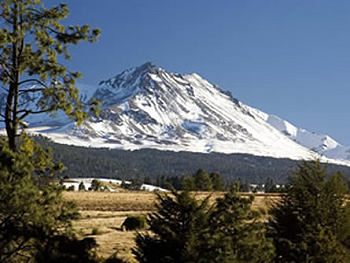In a previous post, we saw how most of Mexico’s volcanoes are located in a broad band that crosses central Mexico known as the Volcanic Axis (Eje neovolcánico). In this post, we provide brief descriptions of some of the major volcanoes in Mexico.
Starting in the west, the first active volcanoes are Everman and Barcenas in the Revillagigedo Islands. Two of the westernmost volcanoes on the mainland are near Colima. At 4260 m (13,976 ft), the inactive Nevado of Colima, Mexico’s sixth-highest peak, is as tall as the highest mountains in the contiguous USA. Its younger brother, Colima Volcano (or Volcán de Fuego) is lower (3820 m) but highly active and considered potentially very dangerous. It has erupted in cycles for several hundred years, and is capped by a dacitic plug characteristic of a silica-rich Pelean volcano. Such volcanoes have the potential to erupt suddenly, not emitting vast quantities of molten lava, but shooting out less spectacular, but far more devastating, clouds of red‑hot asphyxiating gasses.
Tequila Volcano, overlooking the town where the beverage is distilled, is also in Jalisco. In neighboring Michoacán state, the most noteworthy volcanoes are Jorullo (which last erupted in 1759) and Paricutín, which began life in a farmer’s field in 1943 and ceased activity in 1952, but only after its lava had overwhelmed several small villages.
Closer to Mexico City, the Nevado of Toluca (4680 m) has a drive-in crater and is a favored destination for Mexico City families in winter to take their children to play in the snow. It is Mexico’s fourth highest peak (see table below).
Volcano States Height (meters) Height (feet)
Pico de Orizaba Veracruz; Puebla 5 610 18 406
Popocatapetl México; Morelos; Puebla 5 500 18 045
Iztaccihuatl México; Puebla 5 220 17 126
Nevado of Toluca México 4 680 15 354
Malinche Tlaxcala; Puebla 4 420 14 501
Nevado of Colima Jalisco 4 260 13 976
Cofre de Perote Veracruz 4 200 13 780
Tacaná Chiapas 4 080 13 386
Telapón México 4 060 13 320
El Ajusco Federal District 3 930 12 894
Colima Volcano Jalisco; Colima 3 820 12 533
Continuing eastwards, we reach several other volcanoes that are among Mexico’s highest volcanic peaks (and are also included in the table).
The most famous volcano in the Volcanic Axis is the still active Popocatepetl (“Popo”), which rises to 5500 meters (18,045 feet). Alongside Popocatepetl is the dormant volcanic peak of Iztaccihuatl (5220 m or 17,126 ft). On a smog-free day, both are clearly visible from Mexico City. The southern suburbs of Mexico City are overshadowed by a smaller active volcano, Ajusco, which reaches 3930 m (12,894 ft).
The Pico de Orizaba, a dormant volcano on the border between states of Veracruz and Puebla, is Mexico’s highest mountain. At 5610 m (18,406 ft) it is the third highest peak in North America. By way of contrast, not very far away, in the outskirts of the city of Puebla, is the world’s smallest volcano!
Only a few volcanoes appear to be located outside the Volcanic Axis and therefore in an anomalous location to the general pattern. They include two volcanoes in Chiapas which lie south of the Volcanic Axis: El Chichón (which erupted in 1982) and Tacaná (4080 m).
Related posts:
- Alert level rises as Popocatepetl volcano starts to erupt
- The world’s smallest volcano is in Puebla
- An early ascent of Mexico’s highest mountain, El Pico de Orizaba
- The story of Paricutín volcano in Michoacán
- How Mexico’s fourth highest peak got its name
- Mexico’s geomorphosites: the volcanic spine of Tequila Volcano, Jalisco
- The eruption of El Chichón volcano in 1982

Sorry, the comment form is closed at this time.